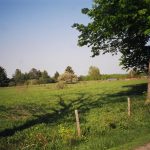Buried in the Eastern end of our municipality lies a hill unlike any other hill. Tourists come from far to see the hill. Movie producers have discovered the hill for all its beauty and wonderment. Some wonder where it got its name. When I moved here 2 years ago with my family, my daughter asked me where all the pigeons were. It seemed peculiar to a six year old that a place named Pigeon Hill had no pigeons ! We were later informed by a bank teller in Bedford that Pigeon Hill actually got its name from a French man named Mr. Pigeon.
There probably are some pigeons flying free in the vast wilderness that makes up the land of Pigeon Hill. Several birds make their home in Pigeon Hill as well as many other species. Deer, coyote, fox being among the few. One can certainly understand what brought our forefathers to this green land of peace and glory. The Mississquoi Museum can date back to 1780 when it is believed that Mr. George Tittemore became the first settler in Pigeon Hill. Others followed over the years and a vibrant village was formed. In the 1860s, many Irishmen living in the United States wanted Britain to grant independence to Ireland. Ireland was under English rule and most of its people lived in severe poverty. The Irish potato famine of the 1840s had decimated Ireland’s population and England had offered little help. Thousands of Irish families migrated to North America in search of a better life.
Between 1847 and 1861, over two million Irish crossed the Atlantic. Many Irish, both in America and in Ireland, were bitter towards England, and sought independence for Ireland. A radical group known as the Fenian Brotherhood was formed. Their aim was to take Canada hostage and force England to grant independence to Ireland.
I
n 1866, the Fenians launched a series of raids on Canadian territory. One was at Pigeon Hill. Led by a man named « General » Samuel Spear, several hundred Fenians marched six miles into Canada, where they planted a bright green flag. A small Canadian force saw them coming, but wisely retreated. The Fenians met no soldiers, so they busied themselves by stealing chickens, pigs, or liquor from farms in the area. A veritable armed mob, they plundered nearby St. Armand and Frelighsburg (Slab City), and, it was said, « insulted and abused » the local population. On hearing that Canadian reinforcements were approaching, the Fenians began a disorganized retreat to the U.S.
The last 200 stragglers were charged by a volunteer cavalry troop who managed to capture sixteen prisoners. Once back on American soil, the Fenians had their guns confiscated by American soldiers.
Now step forward in time to 1930. A young girl walks from Ecles Hill to Pigeon Hill with her sister to go shopping at the general store. The general store was filled with groceries sold in bulk. Grocery items were weighed to be priced. Farmers shopped at the general store to buy rakes, hoes, shovels and seed for their crops. There was also a small supply of men’s clothing kept on hand. The young girl, Marjorie Jones Piette, recalls walking in to the general store and seeing a big pot belly stove burning with several men sitting around talking. The general store served as a meeting place for many folks. Today, the general store is home to an art gallery.
Pigeon Hill was also home to a hotel. We can date the hotel back as far as the 1800’s. The hotel served a few kinds of beer and other spirits. They also had orange soda for those who preferred non-alcoholic beverages. Mrs. Piette recalls sneaking in to the hotel after one of her long walks from Ecles Hill. It was a hot summer day. Farmers were coming in from working the fields. Music was playing on the Nickelodeon and people were doing the Charleston on the tables. The hotel also offered live music and dancing on Friday and Saturday nights. The village also consisted of a church established in 1865, a school and a mill for corn and wheat. There was also a gas station and garage.
The village no longer offers any of the mentioned services. Modern technology has forced the centralization of commerce and school in larger urban centers. The church is still open but only during summer hours as there is no heat or electricity. Pigeon Hill is now home to a few hundred individuals from all walks of life. There are families living here with strong roots in the community. Newcomers have been transplanted here from other nearby communities or some come from as far away as Russia and Europe. Potters are inspired by their surroundings. Painters and photographers find colors and vibrancy in the land. Authors find peace and tranquility. And just as Mr. Tittemore did back in 1780, new families continue to find a place to call home in Pigeon Hill.











